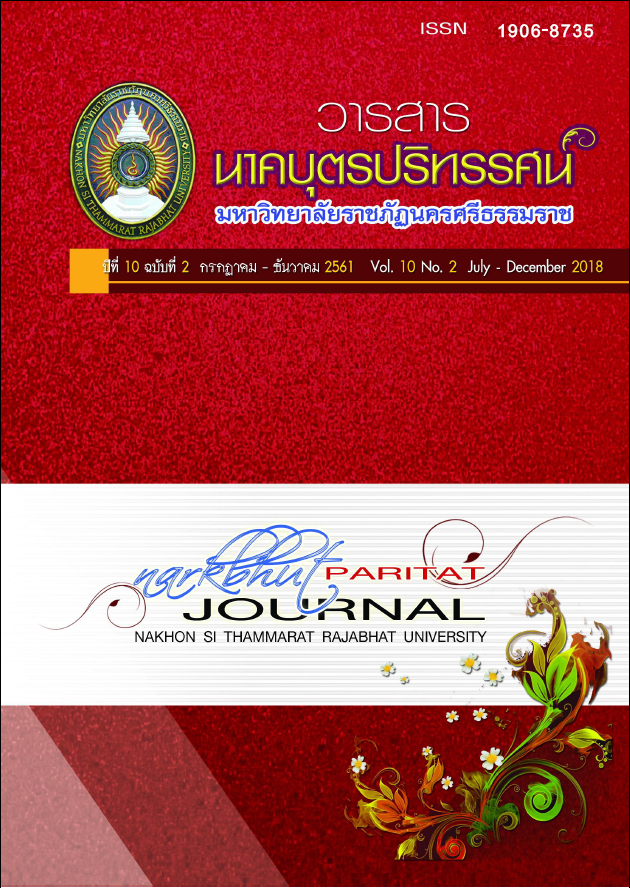The Youth Behaviors of Using Mobile Phone in Nakhon si Thammarat
Main Article Content
Abstract
The purpose of this research was to study youth behaviors in using mobile phone in Muang District, Nakhon Si Thammarat (NST) Province. The sample of this research was youths chosen from 5 educational institutes—2 large high schools, 2 vocational schools (1 private and 1 government vocational schools) and 1 non-formal and informal educational institution—in Muang District, NST Province. 127 youths divided into 2 groups, 61 performers and 50 general informants, chosen by using purposive sampling method. Data was collected by using interview, observation, and focus group discussion. Data was analyzed by using triangulation technique. Then results were presented by using descriptive analysis.
The research shows that there were 3 aspects of youth behaviors in using mobile phone in NST Province. The first was an aspect of communication behavior. Language mostly used in everyday conversation was both polite and impolite. To text faster on mobile phones, short words or Baew language (language used to act cute or innocent) was used to text and receive messages to their friends, family members, and parents. For internet searching, they mostly used chat room to chat with their friends or boyfriends/girlfriends rather than chatting with their parents or teachers. In some case, they had phone sex with their boyfriends/girlfriends at night. They also sometimes used the mobile phones for learning reason. The second was an aspect of entertainment behavior. They used the mobile phones to send, receive, and make video clips for improving their knowledge and for entertaining. To entertain, they liked watching porn clip videos, listening to music, playing games— teenage boys generally liked playing violent games that could make them meet the challenge— watching cartoons or Korean series, buying and selling products online. For the third aspect, modernity behavior, modern and well-decorated mobile phones which could present the social status were likely to be prior choices for the youths in making decision to buy the new one. They changed their mobile phones every 1-2 years for showing the modernity. The other choices were color, decoration, interesting additional services such as receiving news or information from network SMS service, downloading calling melody, sending text and voice messages.
Article Details
References
Chaivijarn,S. The setting up of the Self Directed Learning Spaces for Nakhon si thammarat
Rajabhat University’s Students. Nagabut Journal Review, 10 (1). ). Nakhon Si Thammarat: Nakhon Si Thammarat Rajabhat University. (in Thai)
J.H.Steward, Theory of Culture Change : The Methodology of Multilinear Evalution (Urbana :
University of lllinois Press,1955)
Justice System Development Center. (2014). Report of Major Criminal Situations in Area Level, Office of Justice Affairs, Ministry of Justice.
Kaeosanit, M. (2015) Thestudy of new perception level and channal for communication
between community and Nakhon si thammarat rajabhat university. Nagabut Journal
Review, 7 (2). ). Nakhon Si Thammarat: Nakhon Si Thammarat Rajabhat University. (in Thai)
Kongrat, P. (2011). Teenage Behaviors in Using Online Social Media in Thailand: A Case Study of Facebook. Thesis of Master Degree in Technology Administration, Graduate School, THammasat University.
Lampetch, S. (2016). Behaviors and Effects in Using Online Social Media of High School Students in Nonthaburi Province. Faculty of Education, Educational Administration Program, Bangkokthonburi University.
Lertgrai, P. & Nilakan, L. ( 2016 ). Data collection in fieldwork of Community research.
Narkbhut Paritat Journal Review, 7 (2). ). Nakhon Si Thammarat: Nakhon Si Thammarat
Rajabhat University. (in Thai)
Lertgrai,P. Muenhat, S. Nilkarn, L. (2017). Development of theoretical learning organization.
Narkbhut Paritat Journal Review, 9 (1). Nakhon Si Thammarat Rajabhat University.
(in Thai)
Lertgrai, P. & Nilakan, L. ( 2016). Data collection in fieldwork of Communityresearch. Narkbhut
Paritat Journal. Review, 8(2). Nakhon Si Thammarat: Nakhon Si
Thammarat Rajabhat University. (in Thai)
Manlae, W. (2016) The Development of network system for teacher-libraran to
develop self-directed learning of student in Nakhon si thammarat. Narkbhut Paritat
Journal Review, 8 (1). ). Nakhon Si Thammarat: Nakhon Si Thammarat Rajabhat University.
(in Thai)
Mingsiritham, K. (2018). “Social Media – Creative Media for Education” Veridian E-Journal, Su. 6,1:72.
Ministry of Culture. (2007). “Scope of Cultural Monitor” in Handbook of The Establishment of cultural Monitor Center in Provinces and Educational Institutes. Bangkok: Office of the Permanent Secretary of Culture Ministry.
Sangchan, B. (2012). Teenage Behaviors and Attitudes on Chat Language in Bangkok. Independent Study, Master Degree in Public Relations, Graduate School, Sripatum University.
Santasombat, Y. (2013). Human and Culture. Bangkok: 4th ed., Thammasat University.


